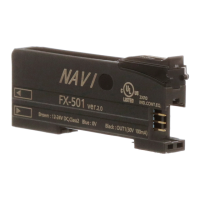9
Pro4 menu
Menu item
Default
setting
Description
Copy setting –
With optical communication it is possible to copy
settings from the main amplier to all sub ampliers
cascaded to the right of the main amplier.
* During the copy process, the FX-502□ cannot send
or receive threshold values.
Copy action
setting
With optical communication it is possible to copy or
cancel settings for the display adjustment or the incident
light intensity. If the incident light intensity does not have
enough margin, an optimum value is set automatically.
The display of the main and sub ampliers
can be adjusted. Set the target value in each
amplier.
The incident light intensity of the main amplier
can be copied to the sub ampliers. However,
when the difference between the main amplier
and sub amplier is big, the value will not be
copied.
The display adjustment of the main and sub
ampliers can be set to OFF.
Copy lock
setting
Individual sub ampliers in a cascade can be prevented
from receiving settings via optical communications by
activating the copy lock (
). The “locked” sub
amplier will not block the optical communication so that
all ampliers installed behind it will receive the copied
settings.
Communica‑
tion protocol
setting
This parameter is used to control optical communication
from the main amplier to sub ampliers. If one of the
sub ampliers is set to halt communication (
),
all ampliers installed behind it will not receive any data
via optical communication.
External
input setting
(only for
FX-502□ and
FX-505□-C2)
Set the function of the external input.
Pro5 menu
Menu item
Default
setting
Description
Code setting
To make exactly the same setting on several ampliers,
use the 8‑digit code instead of manual setting. The code
is also helpful if you wish to conrm the current setting
of an amplier. Refer to the “Code setting tables” on
page 10 for details.
Display
adjustment
setting
Set the incident light intensity to the target value. When
you set the display adjustment while the incident light
intensity does not have enough margin, the display
shows a blinking
.
Display adjustment OFF
Set the display to 0. This redenes the initially
displayed value as zero.
Set to any value within the valid range for inci‑
dent light intensity (negative or positive).
Reset setting –
If you select the setting
, the amplier returns to the
factory settings.
CUSTOM
setting
Select which item should be displayed in CUSTOM
mode: Response time, emission power, or hysteresis.
Interference
prevention
setting
Interference can be prevented only for a limited number
of ampliers when you have selected the default setting
(optical communication). The number of ampliers
depends on the response time you have selected, see
details on page 12.
Use optical communication to prevent interfer‑
ence. A maximum of 12 sensor heads can be
cascaded.
Use up to 3 different emitting frequencies. A
maximum of 3 sensor heads can be cascaded
per frequency setting.
Pro6 menu
Menu item
Default
setting
Description
Sensing out‑
put mode
Set the mode for sensing output 1 and 2.
Normal mode. Sets a threshold value for ON /
OFF operation.
Window comparator mode (only for sensing
output 1 of FX-502□, FX-505□-C2). Sets two
threshold values and judges whether they are
within the required range or not. The threshold
values can be selected in 1 / 2 / 3‑point teaching
(see page 3).
Rising differential mode. Only drastic rises in the
incident light intensity are detected.
Falling differential mode. Only drastic drops in
the incident light intensity are detected.
Hysteresis mode. Changes hysteresis to ignore
small changes to the incident light intensity. The
threshold range can be selected in 1 / 2 / 3‑point
teaching (see page 3).
Self diagnosis mode. Only displayed in
FX-502□, FX-505□-C2 and only available for
sensing output 2.
The self‑diagnosis output can serve as an alarm
output.
Answer back output mode. Only displayed in
FX-505□-C2 and only available for sensing
output 2.
In this mode, the amplier answers all external
signals by outputting the same signal for conr‑
mation after a certain time (see note).
Forced ON output mode. Sets the output forc‑
ibly to ON.
Forced OFF output mode. Sets the output forc‑
ibly to OFF.
* After an external signal has been input, the time until an answer
is output is as follows. Please note that if you have set a timer for
sensing output 2, different output times apply.
Time between input signal and answer
2‑point teaching
Limit teaching
Full auto teaching
20ms after the end of the input signal, the answer‑
back output will switch when the result of teaching
is
.
Display adjustment
20ms after the end of the input signal, the answer‑
back output will switch.
Data bank loading
Data bank saving
520ms after the last rising edge of the input pulse,
the answer‑back output outputs the number of the
data bank channel in pulses.

